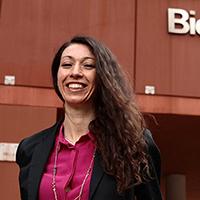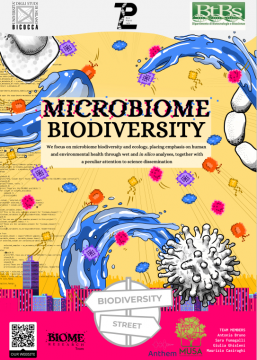Bruno Antonia
Assistant Professor in Microbiology

room 4014, building U4
Scopus ID: 56506478300, ORCiD: 0000-0002-1929-6652, LinkedIn, Biome-Research team
Keywords
microbiome; omics; DNA; biodiversity; health; drinking water; food; skin; built environments; microbial ecology
Background
The starting point and common thread of my research field is DNA analysis, first through DNA barcoding, and then moving to DNA metabarcoding, thanks to omics approaches and to High Throughput DNA Sequencing (HTS) technologies. My training involved the use of molecular techniques based on DNA sequencing for the identification of species, not limiting myself to specific taxonomic groups, but trying to understand biodiversity as a whole, from bacteria to mammals.
With my PhD project, I had the opportunity to explore the microbial communities hosted by unconventional biological matrices, such as drinking water. Thanks to the HTS techniques combined with an accurate experimental design, I was able to detect even "ultrasmall" non-culturable bacteria and the so-called "microbial dark matter" in drinking water.
I have therefore been involved in numerous research activities related to the microbial characterization of complex matrices, which have resulted in several national and international research collaborations.
Research interest

My research activity focuses on the study of the biodiversity of microbial communities and their interactions with the environment and macroorganisms. I have always approached this theme from a multidisciplinary perspective: only through the integration of different techniques and skills a deep knowledge and correct interpretation of biological phenomena can be achieved.
The first line of research in the microbiological field has consolidated the research activity regarding the microbiome of drinking water. Thanks to this research, I started to focus on the microbiome of the built environments (MoBE - Microbiome of the Built Environment).
At the same time, a second line of microbiological research concerns the aquatic ecosystem of aquaculture plants, considering both the water microbiome and that of the plants themselves, intended as built environments.
The third line of research instead focuses on the analysis of the food-related microbiome, to ensure its quality, traceability and sustainability. In this context, research was carried out to explore the microbiome of grapes and wine, and of new insect-based foods.
Thanks to the integration of the skills acquired so far, I was able to coordinate the SeaTraceOmics project, aimed at food traceability by integrating microbiome analysis and host genome analysis.
The most recent challenge is to study the interaction between microorganisms and skin to understand the rules governing health and dysbiosis in this complex ecosystem. SKIOME Project was born from this research objective, a data-driven project based on the collection, harmonization, re-analysis and integration of skin microbiome data.
From a broader perspective, my goal is to uncover the relationships between microbial dynamics, environment, and health. This is achieved thanks to the continuous drive towards interconnection in the research activities that I conduct, integrating the different experiences that I have gained working in a heterogeneous research group.
Research projects
SeaTraceOmics (funded by the Bicocca Starting Grants 2020)
Selected articles
1. Bruno, A., Fumagalli, S., Ghisleni, G., & Labra, M. (2022). The Microbiome of the Built Environment: The Nexus for Urban Regeneration for the Cities of Tomorrow. Microorganisms, 10(12), 2311. DOI: 10.3390/microorganisms10122311
2. Agostinetto, G., Bozzi, D., Porro, D., Casiraghi, M., Labra, M., & Bruno, A.* (2022). SKIOME Project: a curated collection of skin microbiome datasets enriched with study-related metadata. Database, Volume 2022, 2022, baac033. DOI: 10.1093/database/baac033
3. Galimberti, A., Bruno, A., Agostinetto, G., Casiraghi, M., Guzzetti, L., & Labra, M. (2020). Fermented food products in the era of globalization: tradition meets biotechnology innovations. Current Opinion in Biotechnology, 70, 36-41. DOI: 10.1016/j.copbio.2020.10.006
4. Bruno, A., Sandionigi, A., Rizzi, E., Bernasconi, M., Vicario, S., Galimberti, A., Cocuzza, C., Labra, M. and Casiraghi, M., 2017. Exploring the under-investigated “microbial dark matter” of drinking water treatment plants. Scientific Reports, 7. DOI: 10.1038/srep44350
Bruno’s Lab – #BrunoLab_BtBs
last update: June 2023